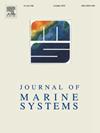Spatial distributions of acoustic scattering groups during the warm-to-cold transition period in the Senegal coastal ecosystem and their relationships with environmental variables
IF 2.5
3区 地球科学
Q2 GEOSCIENCES, MULTIDISCIPLINARY
引用次数: 0
Abstract
The coastal area of north-west (NW) Africa is a highly productive ecosystem due to the presence of a strong upwelling. This ecosystem supports large populations of small pelagic fish, such as sardinellas, which have significant socio-economic value for local populations. In this study, we analyzed the acoustic data collected during a one-month survey along the Senegalese coast at the beginning of the upwelling season. Hierarchical clusterings were performed to classify the acoustic data from the epipelagic zone (down to 120 m-depth) separately for daytime and nighttime. The analysis identified five echo-groups during the day and six at night. The resulting echo-groups were then compared to stratified midwater trawl samplings to support hypotheses about the organisms responsible for the echoes. Additionally, a remotely operated towed vehicle (called Scanfish) was used to monitor environmental variables down to 100 m depth. Two machine learning models were applied to link the classified echo-groups to the environmental data for both day and night. Each daytime echo group had a corresponding nighttime echo group, with also similar environmental preferences. Fish schools were mainly found in shallow coastal waters while dense sound-scattering layers detected at 38 kHz, likely composed of small fish or fish larvae, were observed in the temperature range of 17°-21 °C for both day and night. The other echo-groups were composed of fluid-like zooplankton or gas-bearing zooplankton. The sixth night echo-group corresponded to migrant organisms and was predominant at night. Overall, the analyses of the abiotic habitats for each echo-group allow us to better understand the organism distributions during the beginning of the NW Africa upwelling season.
塞内加尔沿海生态系统冷暖过渡期声散射群的空间分布及其与环境变量的关系
由于强大的上升流的存在,西北非洲沿海地区是一个高产的生态系统。该生态系统支持大量小型远洋鱼类,如沙丁鱼,这些鱼类对当地人口具有重要的社会经济价值。在这项研究中,我们分析了在上升流季节开始时沿着塞内加尔海岸进行的为期一个月的调查中收集的声学数据。采用分层聚类方法,分别对白天和夜间的上层海域(深至120 m)声学数据进行分类。分析发现白天有五个回声组,晚上有六个。然后将得到的回声组与分层的中水拖网样本进行比较,以支持有关产生回声的生物体的假设。此外,远程操作的拖车(称为Scanfish)用于监测100米深度的环境变量。应用两个机器学习模型将分类回声组与白天和夜晚的环境数据联系起来。每个白天回声组都有相应的夜间回声组,也有相似的环境偏好。鱼群主要分布在浅海沿岸水域,而在17°-21°C的昼夜温度范围内,在38 kHz检测到密集的声散射层,可能由小鱼或鱼苗组成。其他回声群由流体状浮游动物或含气浮游动物组成。第六夜回声组与迁徙生物相对应,夜间回声组居多。总的来说,对每个回声群的非生物栖息地的分析使我们能够更好地了解西北非洲上升流季节开始时的生物分布。
本文章由计算机程序翻译,如有差异,请以英文原文为准。
求助全文
约1分钟内获得全文
求助全文
来源期刊

Journal of Marine Systems
地学-地球科学综合
CiteScore
6.20
自引率
3.60%
发文量
81
审稿时长
6 months
期刊介绍:
The Journal of Marine Systems provides a medium for interdisciplinary exchange between physical, chemical and biological oceanographers and marine geologists. The journal welcomes original research papers and review articles. Preference will be given to interdisciplinary approaches to marine systems.
 求助内容:
求助内容: 应助结果提醒方式:
应助结果提醒方式:


